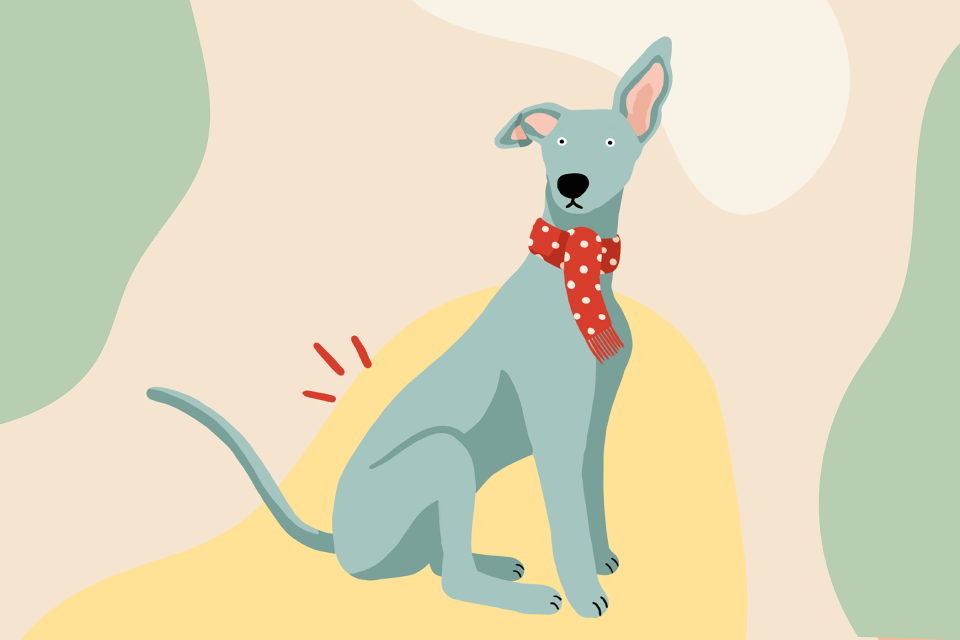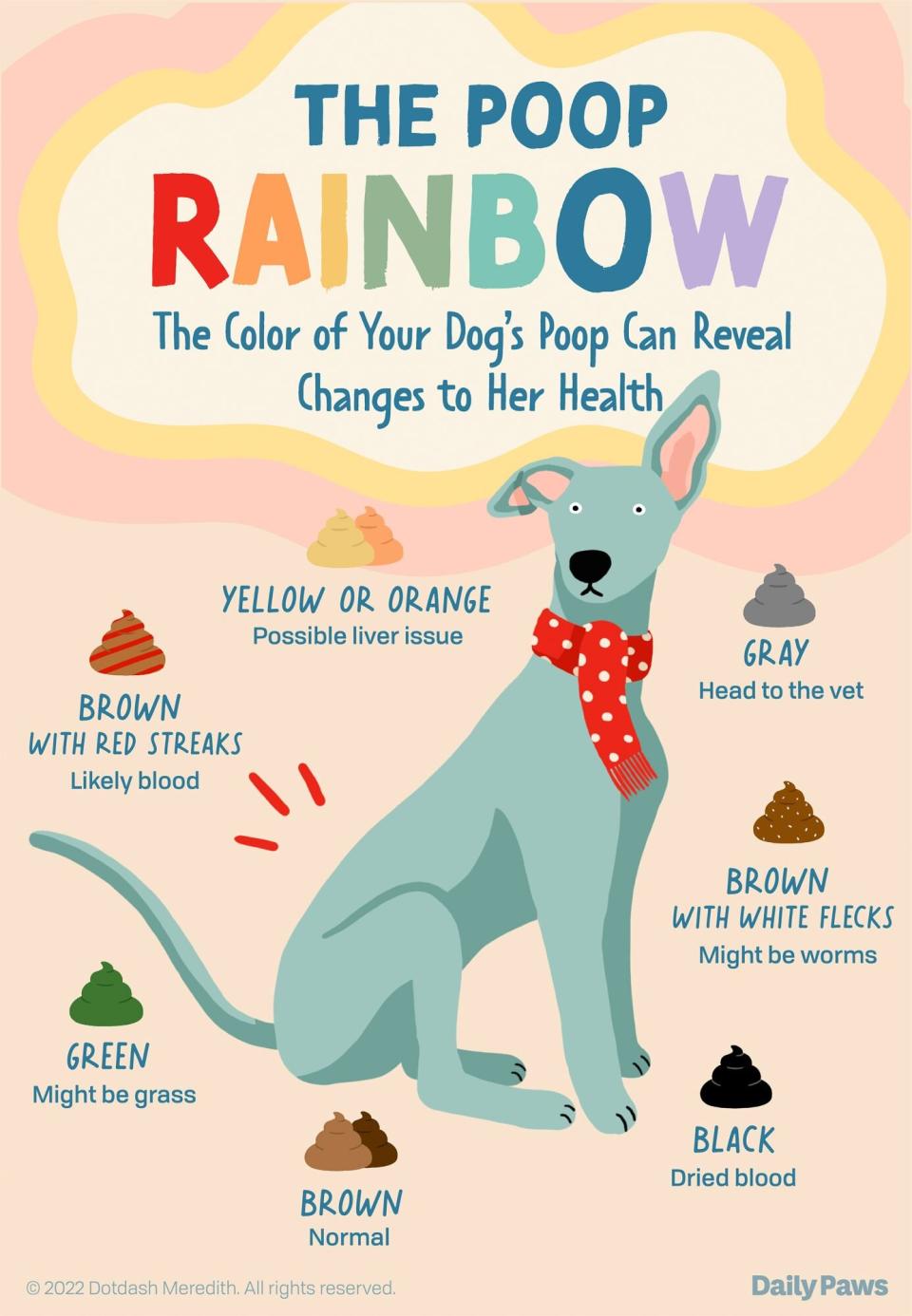Diarrhea in Dogs: What Your Pup's Poop Says About Their Health
TABLE OF CONTENTS
On This Page
Causes
Poop Color
When to Call the Vet
Treatment
Cleanup Tips
If you've owned a dog for any amount of time, you have experienced the joy of a dog with diarrhea. If you're lucky, your poor pooch got you out the door in time. If you're not lucky, well … you had some cleanup to do.
Normally, dog poop develops over an approximately 10-hour journey through the digestive tract and comes out as a firm but malleable brown log. Water, nutrients, and electrolytes are absorbed along the way. When something disrupts this process, food can go through the gastrointestinal tract too quickly, resulting in a soft or even watery mess.

Grace Canaan / Yeji Kim
What Causes Diarrhea in Dogs?
There are many potential causes of diarrhea in dogs, but these are some of the most common:
Dietary Indiscretion
This is often the culprit—when your dog eats something she shouldn't have, like rotting vegetables out of the garbage, the turkey carcass off the counter, or an unidentified dead thing out in the yard.
Change in Diet
Switching to a new food too quickly can upset the GI tract.
Stress
Moving, staying at a boarding kennel, loss of a family member, and even a visit to the vet's office can all lead to diarrhea, particularly in anxious dogs.
Parasites
This includes worms, Giardia, and coccidia, which all irritate the GI tract and cause diarrhea. In some cases, you may even see worms or segments of worms in your dog's stool.
Viral Infections
Infections like parvovirus and distemper cause diarrhea along with other symptoms of illness. Both of these viruses are extremely contagious and deadly but can be prevented with vaccinations.
Food Allergies and Intolerances
True food allergies are rare in dogs, but food intolerances can occur at any age. These conditions can be difficult to diagnose and are managed by avoiding the problem ingredient(s).
Foreign Body
This is when your dog eats a non-food item, such as a toy or item of clothing. These items can get stuck in the GI tract and cause an obstruction. As well as diarrhea, an affected dog will also likely have abdominal pain, a poor appetite, and may vomit. Surgery may be required to remove the blockage.
Bacterial Infections
These could include infections such as E. coli and Salmonella.
Illnesses
Including inflammatory bowel disease, colitis, or cancer.
Medications
Your veterinarian will warn you about medications that tend to have diarrhea as a side effect, but individual dogs may tolerate medications differently.
Toxins
If your dog has ingested something toxic such as medications, toxic foods like chocolate or grapes and raisins, poisonous plants, toxic household cleaners, or pest control products, diarrhea may be the first sign of poisoning.
RELATED: Why is My Dog Vomiting? (and What to Do About It)
What Your Dog's Poop Color Can Tell You About Their Health

Grace Canaan
Brown
A good, normal poop; a great poop even. This is the only color you want to see in your dog's stool. The brown can range from a lighter shade to something that looks more like coffee.
Brown with White Flecks
Your dog probably has worms, probably either tapeworms or roundworms. Tapeworms look like grains of rice in the poop while roundworms and similar worms look stringy and spaghetti-like. Ew. If you see this, it's time to take your dog to the vet.
Yellow or Orange
Time to head to the veterinarian. Orange diarrhea could indicate nothing, but it could also mean your dog is experiencing a liver problem. Same for yellow-colored poop, too.
Green
Has your dog been eating green things—grass, leaves, or green food? That could be the reason. But, your dog could also have a gallbladder issue. Head to the vet to make sure.
Red or Red Streaks
That means blood, likely from the lower gastrointestinal tract. Go to the vet.
Black
This is also blood—it's just dried and originated in the upper GI tract. Again, head to the vet's office.
Gray
Not good. This could be a sign your dog is dealing with pancreatic issues like exocrine pancreatic insufficiency, which causes an inability for your dog to absorb the necessary nutrients. The poop will also look greasy or pasty. Go to the vet right away.
Multicolored
Did your dog eat a bunch of crayons? (This should be impossible.)
When Diarrhea Becomes a Health Emergency for Your Dog
Most cases of diarrhea are caused by dietary indiscretion, a diet change, or stress and will resolve quickly on their own. However, if any of the following situations apply, call your veterinarian ASAP.
Diarrhea that lasts more than two days (risk of dehydration)
Diarrhea accompanied by vomiting (high risk of dehydration)
Diarrhea in a dog or puppy who is not fully vaccinated (diarrhea is one of the first signs of parvovirus, and catching it early can save your puppy's life)
Bloody stool
Black stool (the color of digested blood)
Grey, greasy-looking stool
Abdominal pain
Any time you are unsure
Bring a sample of your dog's stool with you to the vet's office if you can. Observing the stool in person can be helpful for determining the cause, and your veterinarian will likely run a fecal analysis and look at a small amount of the stool under a microscope for signs of parasites.
Other diagnostics might include blood work and radiographs (X-rays) depending on any other symptoms that your dog may have.
Dog Diarrhea Treatment and Home Remedies
Diarrhea in an otherwise healthy dog can be treated conservatively at home to start.
Try fasting your dog for 12–24 hours—no food or treats, but keep fresh water available at all times. This gives your dog's GI tract a chance to calm down and reset.
Warning: fasting should not be done in puppies under one year of age or under 20 pounds of weight as it poses the risk of low blood sugar, which can cause serious complications. Contact your vet if you have a puppy or a small dog with diarrhea.
After the fast, offer your dog a bland diet. Options include cooked white rice, plain canned pumpkin (not pie filling!), boiled skinless chicken breast, cooked pasta, boiled potatoes, and plain cooked lean hamburger. If your dog tolerates the bland diet well, the next day you can mix it with some of her regular food and slowly switch her back over to her normal food over the next few days. Many dogs enjoy their special bland foods, but these diets are not balanced and are not appropriate for long-term use. An alternative is to pick up a prescription food from your veterinary office that is designed to be gentle on the GI tract.
Prebiotics and probiotics can be beneficial for preventing and resolving diarrhea. These products can be given safely long-term or on an as-needed basis. Some dogs benefit from taking probiotics before and during stressful events like staying at a boarding kennel or moving. Not all supplements are created equal, so choose a product with the National Animal Supplement Council Quality Seal or that is recommended by your veterinarian.
RELATED: About Dog Vitamins and Supplements, Plus 10 High-Quality Options
If your dog is diagnosed with worms, your veterinarian will likely prescribe a dewormer. Most dogs benefit from being kept on a regular deworming schedule to prevent infections.
For more stubborn cases of diarrhea, your veterinarian will break out the antidiarrheal medications metronidazole (brand name Flagyl) or tylosin (brand name Tylan). These medications can be combined with other methods to get your dog's poop back to its proper texture.
RELATED: The Best Pet Stain Removers for Every Type of Mess
Diarrhea Cleanup Tips
Clean messes promptly. While the smell may be terrible, it will be much easier to clean up before it sets.
Hose off dog beds, blankets, or throw rugs either outside or in the tub to remove fecal debris before putting the item in the washing machine. For items that can't be machine washed, follow hosing with an appropriate spot cleaner.
For messes on carpeting, start by removing as much of the stool as possible, then blot the remaining mess with a damp towel or paper towels. Blotting helps to remove fecal debris without mashing it deeper into the carpet. When the towel comes back clean, use an appropriate carpet cleaner to address any stains or odors.
Don't forget the dog! Fluffy and longhaired dogs in particular can get some diarrhea stuck on their hind ends. Give your dog a bath by gently hosing your dog off outside or in the tub, and follow with a dog-safe shampoo if needed.

